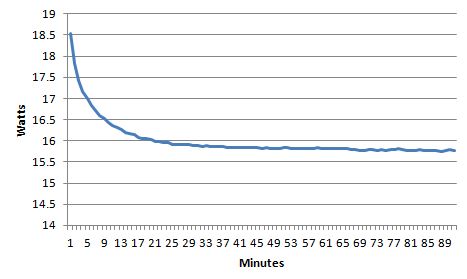FAQ - LED Wattage Claims
Based on our measurements, except for a few brands and faulty products, the actual power consumption of an SSL product with no external driver can usually be expected to fall within ±1W of the manufacturer's claimed wattage. Light types that use external drivers like MR16s can further complicate the matter of power consumption. The inherent inefficiencies of different transformer/MR16 light combinations can influence the wattage, light output and overall efficacy of the system. And while LED kits often come complete with the manufacturer recommended driver, specifications can sometimes fail to include the power consumed by the driver on top of that of the light source.
The power consumed by an LED light can itself vary with time as the LED junction temperature heats up, causing a drop in the forward voltage across the LED and consequently in the light's wattage and light output. It is up to the manufacturer to correctly specify the wattage based on the light's power consumption after stabilisation i.e. reaching thermal equilibrium. The drop in the power consumption of Brightgreen's D900 LED kit over a 90 minute period can be seen in the figure below. After this period, the light was found to settle at the manufacturer's claimed 15.7W power consumption.

The power draw and light output of LED products typically change with junction temperature. Upon starting up, the LED light electronics are still cool. Light output and power are at their highest. As the LEDs continue to operate, the LED junction temperature increases and the voltage drop across the die decreases, leading to a drop in power and, consequently, light output. The decrease in voltage drop with temperature varies across LED manufacturers, generally being a characteristic of the die.
Related Pages
- Efficacy: The Relationship between LED Light Output and Wattage
- Comparison of LED and CFL Light Warm-up Times
Back to FAQ index